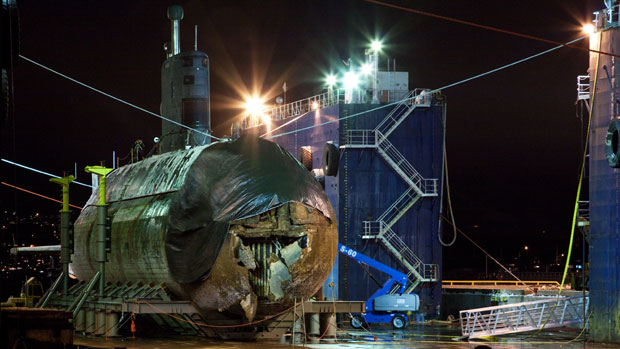John Ivison recounts the ill-fated story of the Royal Canadian Navy’s current submarines in the National Post:
The Liberal government bought four second-hand subs for $750-million from the British in 1998 and renamed them the Victoria class — HMCS Victoria, HMCS Windsor, HMCS Chicoutimi and HMCS Corner Brook.
Since then, billions more have been spent trying to “Canadianize” the subs, including thousands of dollars blown trying to stop pigeons roosting in them, such is the length of time they have been in dry-dock. At various times over the past 10 years, the whole fleet has been out of commission.
The history of Canada’s submarine fleet would be laughable, were it not so tragic. People in government at the time remember the surprise expressed by Liberal ministers that the Defence department accepted the British military’s statement of quality assurance, without doing their own due diligence. That the buyer should have been more wary quickly became apparent.
The Chicoutimi caught fire on her maiden voyage from Faslane in Scotland in October 2004, with the death of one sailor and smoke-inhalation injuries to nine others. The sub has been in dry-dock ever since and is scheduled to return to service in 2013, although some stories have suggested 2016 is more realistic and others that she may never again be operational.
I blogged about HMCS Chicoutimi at the old blog, when it was expected that she’d be back in service in 2010.
Last year, HMCS Corner Brook had what some wag at the Department of National Defence characterized as a “fender bender”:

Some fender. The CBC reported on the extent of the damage:
The Canadian navy admitted that the submarine crashed off British Columbia in June, but it never described the extent of damage or released a photograph.
“I was gobsmacked. I had no idea that this level of damage had occurred,” said Senator Colin Kenny, the former head of the Senate defence committee. “That may explain why the navy took it out of the water at night.”
[. . .]
Some familiar with the submarine say its pressure hull, the area in which the sailors are housed, may be heavily damaged and that would mean the sub will never go to sea again.
“Canada needs a submarine fleet, and to have this boat not be available would be tragic,” Kenny said
The RCN claimed that there was no cover-up and that they have been completely above-board and “transparent” about the incident. It’s an odd definition of “transparency” that requires you to submit a formal Access to Information request to get the report — and the photos of the damage to the hull were censored from the report anyway.
Back in 2004, it was reported that our submarines were without torpedo armament, but that they would be “fully armed” by 2006. The CBC report mentioned in passing that eight years later, they’re still lacking torpedoes:
The navy said HMCS Windsor is to undergo trials “in the coming months” and is also expected to be back in operation later in 2012.
Not one submarine is capable of firing a torpedo, however the navy said Tuesday that a test firing of a torpedo from HMCS Victoria is planned for the coming weeks and the submarine is supposed to be operational this year.
Back to John Ivison:
In all this time, the fleet has hardly been crucial to our defence. According to people familiar with its role, it has spent time at sea monitoring fishing fleets and acting as “prey” for U.S. forces, who don’t have diesel-electric subs of their own and like to use ours for hunting practice.
Peter MacKay, the Defence Minister, recently lamented the decision to buy the British diesel-electric subs, which are not capable of diving below ice in the Arctic. “In an ideal world, I know nuclear subs are what’s needed under deep water, deep ice,” he mused.
That we do not live in an ideal world was quickly made apparent by Government House Leader Peter Van Loan, who all but disowned the fleet in a response to a question in the House. “There is no plan to replace the diesel-electric fleet purchased by the Liberals,” he said.
But if there is no plan to replace the fleet, is there a plan to scrap it?
[. . .]
The Navy defines “full operational capability” as having a weapons-ready sub on each coast. It has yet to put one sub to sea that meets that standard, a decade after the first one was received.
The hope is that two boats will be fully operational within two years, with a “swing boat” available to take over when one goes for refit. That may prove wildly optimistic. Submarines may be a useful addition to our battery of defences — but only if they work. And not at any cost.
These subs have proven themselves to be lemons, they are already past mid-life and the odds are against us having even three boats with operational capacity at any one time.




